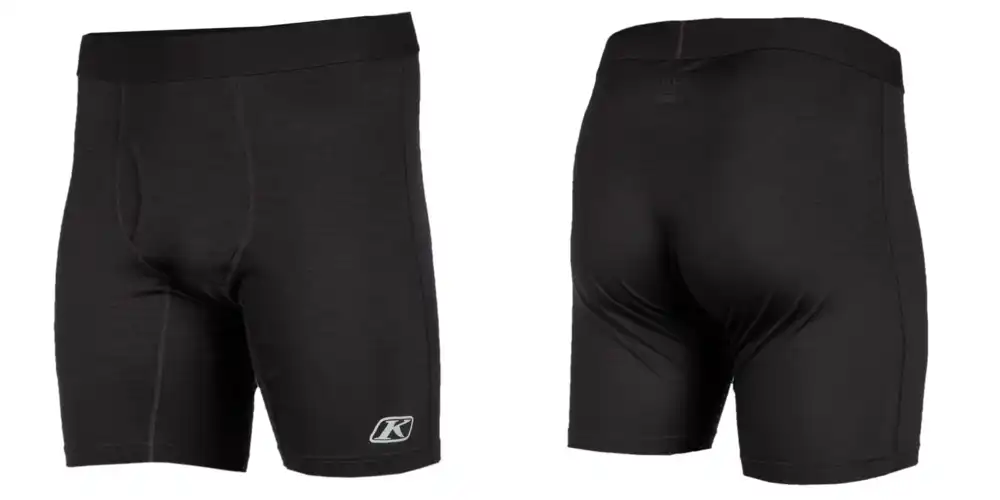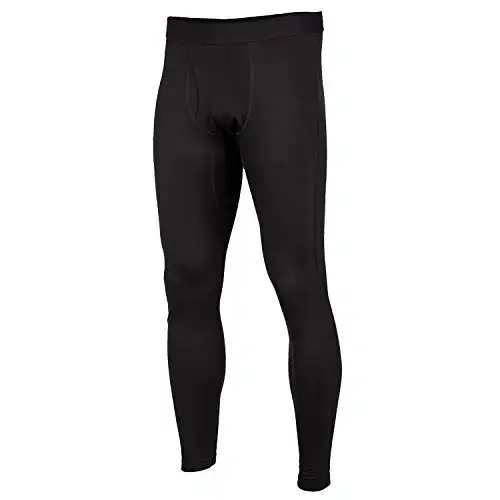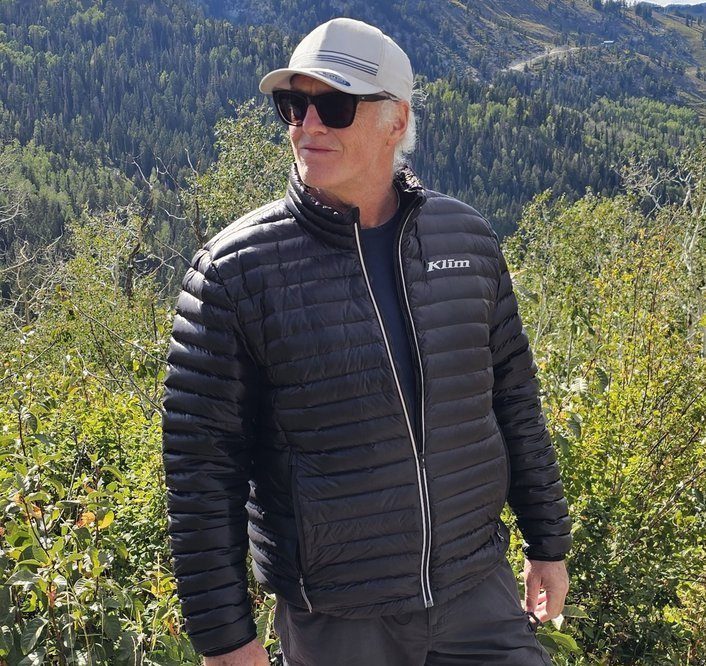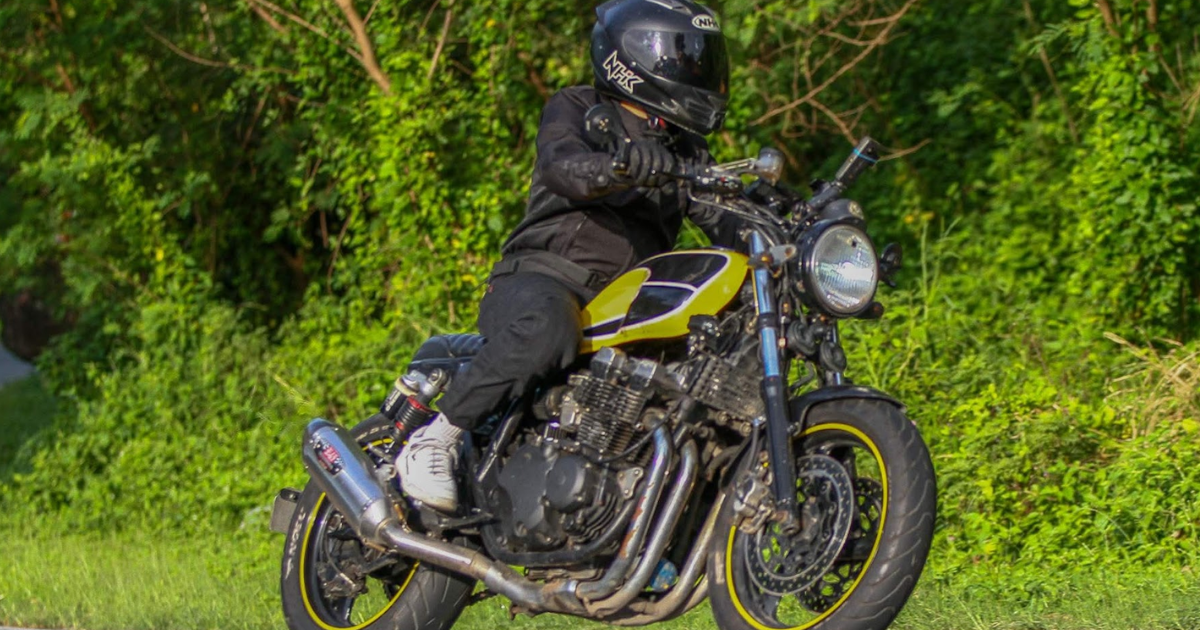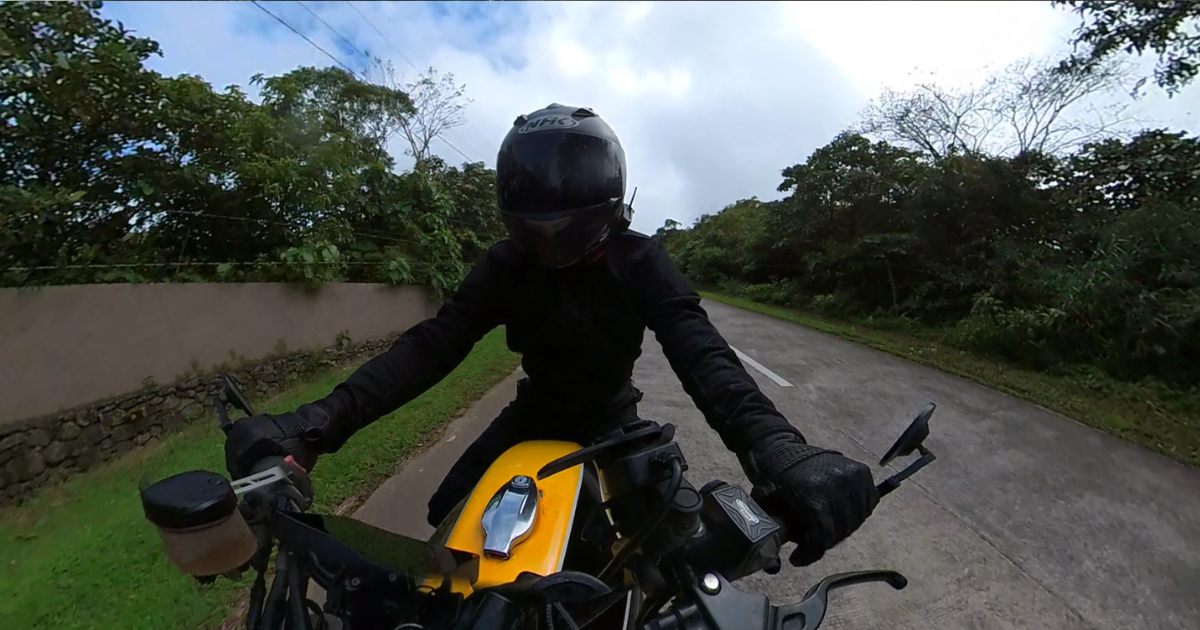
Klim Maverick Jacket and Teton Base Layers Reviewed
left for contents
We all prefer cruising under blue sunny skies, only wearing a protective mesh jacket and pants. However, we’ll need waterproof gear when Zeus, Thor, or other deities in charge of the weather are in a foul mood and unleash their wrath upon us.
Add Boreas, Aquilo, or other gods of winter into the mix, and we’ll need warm clothing under our riding jacket and pants to cope with the plummeting temperatures. Factor in the windchill, which increases dramatically the faster you go, and you’ll need to upgrade your riding outfit with several warm layers under your winter motorcycle jacket.
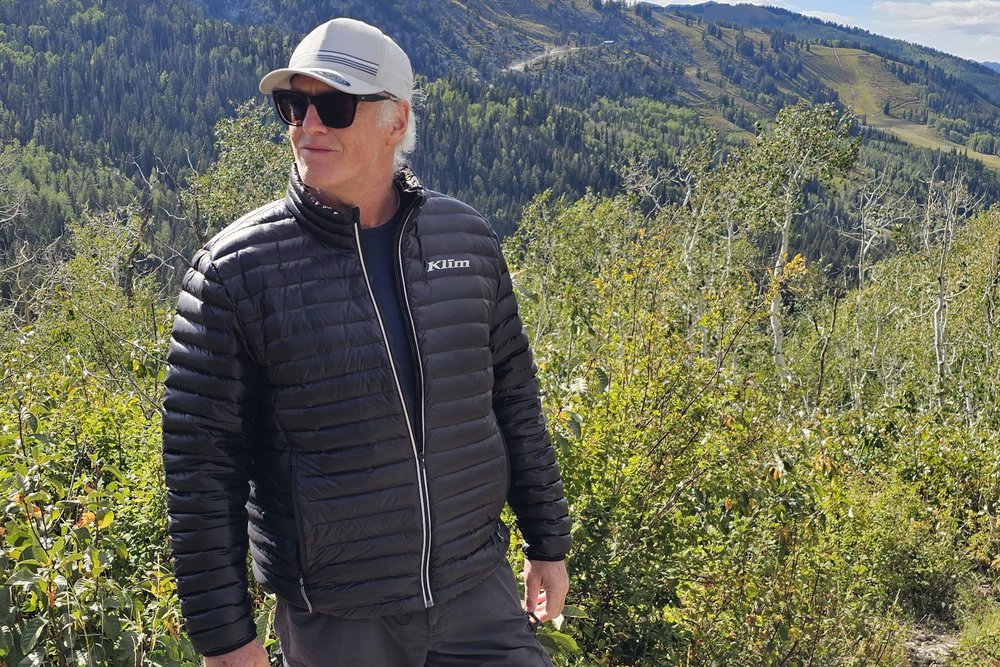
You may delve into your winter wardrobe and don a flannel shirt and knitted sweater or two, but casual clothes are not nearly as effective as layering with base and mid-layers designed to work together.
From my half-century of adventure riding, let me tell you three truths that may not be self-evident:
- Combining technical base layers offers superior thermal insulation, breathability, and moisture-wicking capacity than a single technical outer layer or layered casual clothes.
- A simple cotton shirt is a chill generator when wet – do not depend on this in cold/wet climates.
- The name of the base layers game is temperature regulation, not trapping heat in or out. This has to do with sweat and wind, which I’ll get in to.
Skipping Below: To skip to any review in this article, slide out the Table of Contents by swiping right to left or clicking the button that’s always hovering in the bottom right.
If you’re as passionate about riding as we are, hibernating is simply not an option as the primal urge to go riding is too strong to ignore, even if it’s cold. But giving in to that craving doesn’t override your other primal desire. The one for which you don’t want to risk sacrificing your family jewels on Jack Frost’s ice altar.
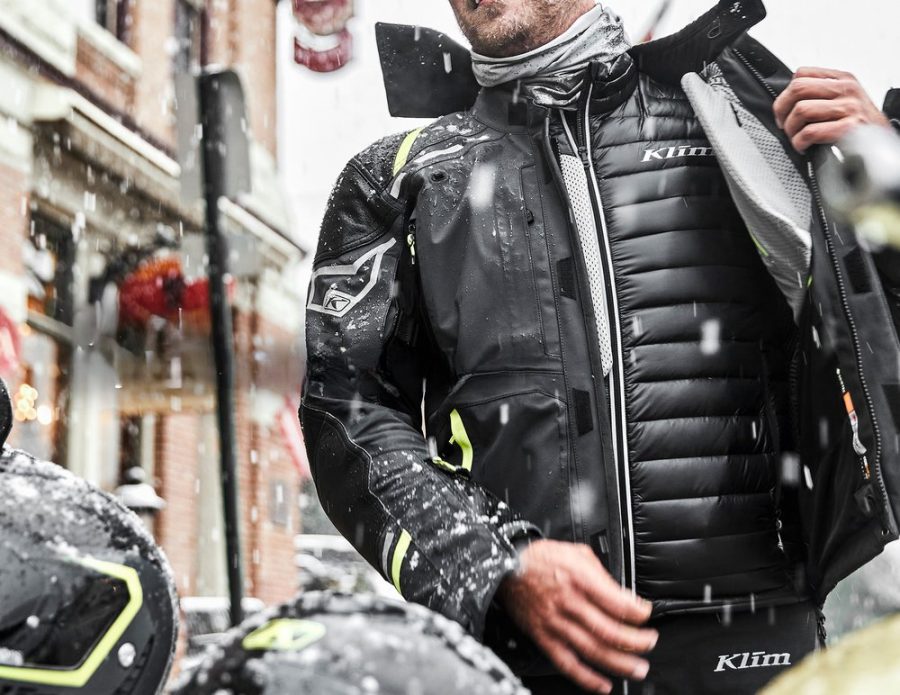
But fear not, “Klim Technical Riding Gear” AKA “The Layering Company” offers a range of thermal base/mid-layers to keep you warm and comfortable. And no, they aren’t just the “most hyped brand” – Klim makes the best technical gear for riding, and I’ve tried just about every piece they’ve produced.
And it doesn’t surprise me that Klim nails layering more than any other manufacturer; they are the world’s #1 snowmobile apparel brand. The folks from Idaho know a thing or two about dressing for the cold!
List of Reviewed Klim Layers

In the following long-term test, I evaluated the three base layers and two mid-layers that kept me cozy and warm on my journeys on three continents over the past year and a half.
Primary Rating:
5.0 | Primary Rating:
5.0 | Primary Rating:
5.0 |
The Mid Layers I tested were the Klim Maverick Down Jacket and Klim Teton Merino Wool 1/4-Zip Shirt which I’ll get in to further down in the review. You can always slide out the Table of Contents to jump to any point in the article by clicking the button in the bottom right or sliding your finger from right to left.
I layered these technical garments under the top-of-the-line Klim Badlands Pro A3 Jacket and Pants (reviewed here) on my ADV journeys and the Klim Traverse Jacket and Pants riding my dual-sport bikes.


You can read my review of the Klim Badlands Pro A3 here. It’s the world’s first—and so far only—CE AAA-rated Gore-Tex triple-layered textile suit, which sets a new benchmark for premium, über-protective, four-season, all-weather ADV gear.
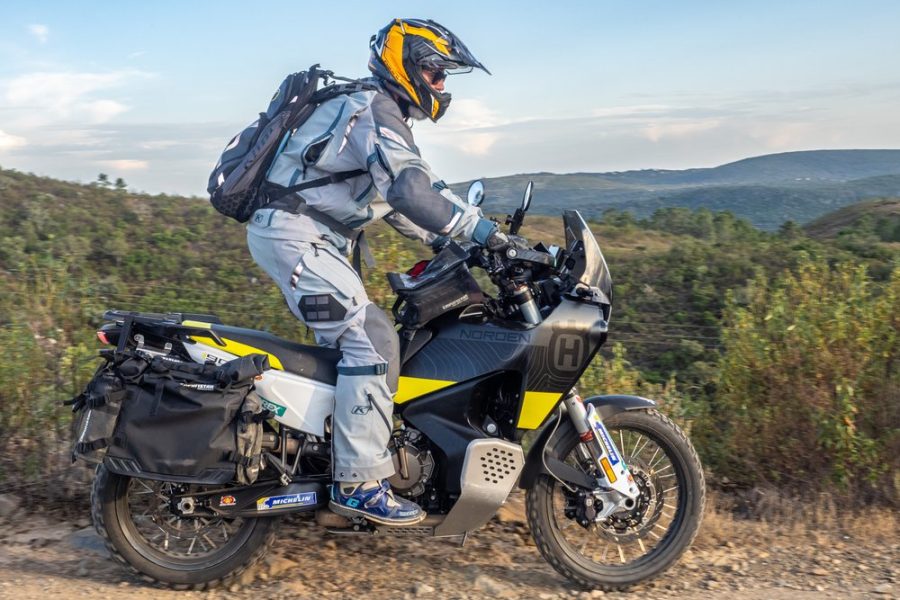
Test Results in a Nutshell
I tested these Klim layers in frigid fall temperatures in the Alps, freezing fog in the Pyrenees, and glacial spells in the Himalayas. It was so cold at times that, if it weren’t for the multiple layers of thermal insulation, I would’ve been forced to abort the trips to avoid turning into an icicle.
Here’s what I found:
- The Klim layering system
- Allows for riding in all conditions with excellent thermal performance and versatility.
- Makes for more enjoyable and safer riding by regulating your body temperature.
- Merino wool offers:
- Superior thermal insulation (more comfort with less gear)
- Moisture wicking (sweat doesn’t mix with cold air to make you an icicle)
- Multi-day odor resistance (HUGE when doing any adventure ride)
- Itch-free softness next to the skin. (Trust me, a little itch can ruin an otherwise incredible trip)
- The Maverick Down Jacket
- Is remarkably warm yet ultra-light
- Packs small in one of the hand pockets
- Doubles as a great casual jacket
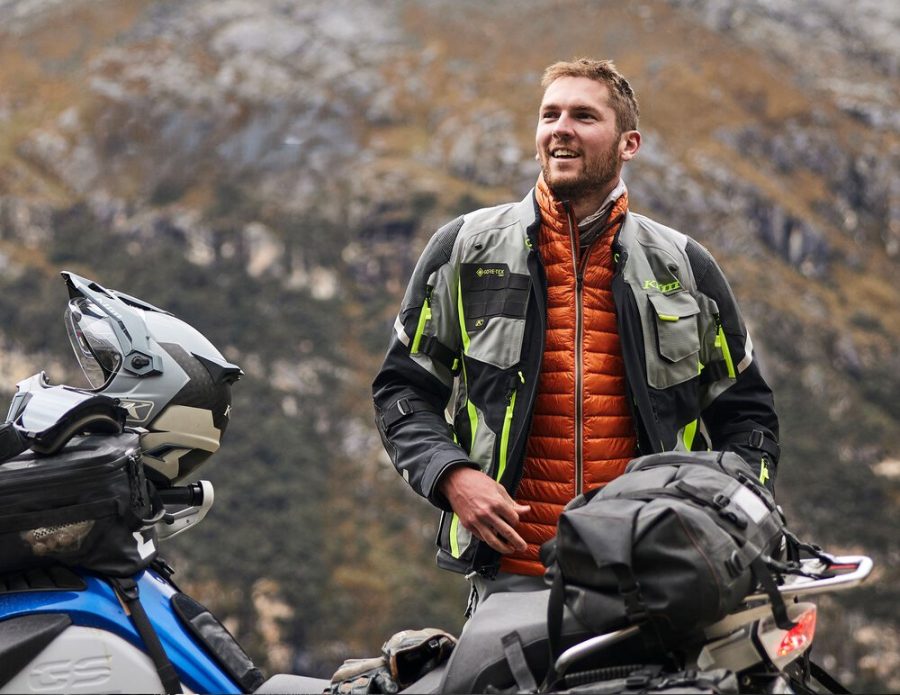
Why Klim for Layering?
This review evaluates a layering system for the colder half of the temperature spectrum. An effective layering wardrobe should consist of carefully selected base layers and mid-layers that cooperate well. This is the case for the Klim base and mid-layers since they are designed to be combined in a layering system.
Worn under your protective outer shell, these layers allow you to continue riding without risking becoming an iceman or melting into a puddle of sweat. In a future review, I’ll discuss technical gear for hot-weather riding.
Unless you’re a newcomer to the “extreme sport” of dual-sport/adventure riding and snowmobiling, Klim Technical Riding Gear needs no introduction. The brand has become synonymous with garments for hard-core ADV/dual-sport/enduro/MX and snowmobile enthusiasts.
If you are a new convert to the ADV/off-road motorcycle lifestyle, know that:
Klim is the global leader in designing, developing, and manufacturing the most advanced technical riding gear and motor sports apparel for the snowmobile and motorcycle rider.
And that’s not a hollow marketing slogan, as insiders acknowledge that Klim sets the benchmark for the motorcycle and snowmobile apparel and gear industry.
Based on its track record in successfully developing gear and apparel for extreme outdoor sports, Klim has earned its self-proclaimed title: KLIM® – THE LAYERING COMPANY
The technical layering apparel I tested for this review uses a blend of merino wool and nylon for the base and mid-layers and goose down for the insulation of the puffy jacket.
Klim Base Layers Reviewed: Klim Teton Merino Wool
For motorcyclists, comfort is paramount, especially on long rides. But finding base layers that can handle the demands of the road – cold, heat, and sweat – can be a challenge.
Let’s start from the innermost: Enter the Klim Teton Merino Wool Boxers, a pair of technical base layer boxers designed to keep you comfortable and confident, mile after mile. Much of what I note here will be applicable to all the Klim Teton Merino Wool base layers.
This section will be low on pictures; you don’t want to look at my underwear.
Klim Teton Merino Wool Boxers
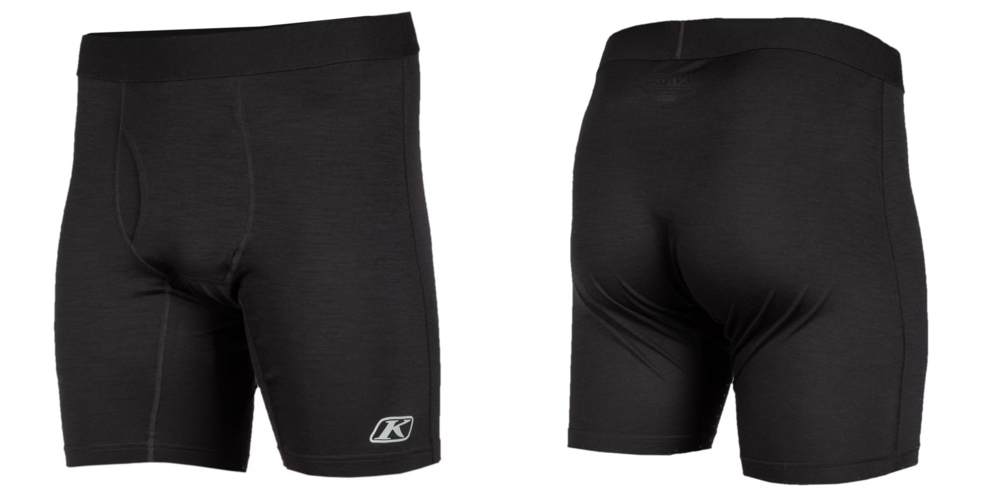
Even in my weirdest dreams, I never imagined that one day, I’d be writing a review of underwear, let alone woolen boxers. I loathed wool throughout my boyhood because of the typical itchiness inherently caused by prickly, coarse woolen sweaters.
It’s beyond an understatement to say I was skeptical when someone recommended trying out undergarments in merino wool. But lo and behold, never before did something as simple as a pair of boxers obliterate my skepticism. The softness of the lightweight merino wool fabric was equaled by the surprising fact that it was itch-free.
The snug-fitting boxers are made from an 80/20 merino wool/nylon blend, prioritizing the natural comfort and odor resistance of merino while adding nylon for durability. The flatlock stitching throughout the garment promises a chafe-free experience, a crucial aspect of any motorcycle base layer.
Hitting the Road
The true test of any base layer lies in its performance on the road. My initial impression of comfort was confirmed during the initial six-week adventure ride through varying weather conditions across Europe.
The merino wool proved to be exceptionally breathable, wicking away moisture effectively and keeping me cool on hot days. When temperatures dipped, the wool’s natural insulating properties provided surprising warmth without feeling bulky.
In Klim’s marketing speak, it’s referred to as “warm and cool reactive temperature regulation”. What matters is that merino wool works exceptionally well at keeping you warm when it’s cold and cool when it’s hot.
Merino’s reactive temperature regulating capacity is a unique quality that makes it versatile. I thought Merino wool base layers would only prove their value in terms of insulation against the cold. I had not expected it to be an effective base layer keeping me cool when it’s warm. On the contrary, I thought I would quickly break out in a sweat in rising temperatures. But thanks to Merino wool’s exceptional breathability and moisture-wicking capability, I kept my cool and my skin sweat-free.
Merino wool is also known for maintaining its insulation when wet. However, as my Klim Badlands Pro A3 combo is waterproof, I never had the chance to test this quality while riding. But I did experience Merino wool’s thermal insulation performance when my Klim Teton Merino Wool Long-Sleeve Shirt got wet during a bicycle ride. It felt definitely a lot warmer compared to a cotton shirt which becomes a chill generator when wet.
Odor Resistance Put to the Test
One of the biggest advantages of merino wool is its odor-resistant antimicrobial nature. I was rather skeptical of the claim of its multi-day odor resistance. However, it didn’t take long to make me a believer.
After a full day of riding, the Teton Boxers remained remarkably fresh. But the amazing feature was the ability to go multiple days without accumulating unpleasant odors. That’s a major perk for me.
Imagine my surprise when I realized I could wear Merino wool shirts and boxer shorts for multiple days without exuding obnoxious odors or starting a mushroom farm in my crotch and armpits.
Wearing boxers multiple days without washing may seem like odd behavior. But on solo explorations of remote areas, my limited luggage capacity forces me to wear my clothes beyond the “laundry due date”, although my wife and children would claim the “disposal due date”. It’s not by choice, but laundromats are scarce in the wilderness. If you have any experience with synthetic undergarments, you know how quickly they become a putrefying biohazard if not washed daily.
Thanks to Merino wool, I no longer have to incinerate my boxers at the end of a trip.
Durability on the move
The 80/20 merino/nylon blend is a winning combination for durability. The boxers held up well to the rigors of long-distance motorcycling, including multiple washes without shrinking. The inclusion of nylon in the fabric blend pays off.
After a year and a half of intensive use, including multi-month adventure trips on three continents, the boxers have kept their form and still fit snugly as the fabric has not worn thin or lost elasticity.
Design Features
The Teton Boxers feature a classic boxer brief design with a comfortable, fairly snug, no-bunching fit. The muted Klim branding ensures a clean look that complements any riding gear. A unique feature is the inclusion of a discreet “crush flap” opening, making those mid-ride sanitary pit stops a breeze.
The Verdict
The Klim Teton Merino Wool Boxers are a “must-have” addition to any motorcyclist’s wardrobe. Their comfort, breathability, moisture-wicking, odor resistance, and durability make them a compelling choice for long rides in both cold and hot weather.
While the price point might be slightly higher than some synthetic base layers, the performance and natural properties of merino wool make it a worthwhile investment. Considering that these could replace 5 pairs of synthetic boxers on the road, their pricing makes them a steal.
These boxers made me rethink my multi-day packing strategy (fewer changes of underwear needed!). Just buy them, it’s a no-brainer. You will thank me later.
Like five pairs of boxers in one, these are moisture wicking, odor-resistant, and don't chafe.
Specs
- Klim-specific custom 80/20 blend of merino wool/nylon specifically designed for the rigors of motorcycling/snowmobiling while remaining 100% functional for casual use and retaining all of the benefits of merino wool.
- Knit from sub-17 micron merino fibers for unequaled comfort.
- 150 GSM merino wool (GSM = Gram per Square Meter, a unit of measurement of fabric weight. 150 GSM is the weight for ultra-lightweight merino wool).
- Extremely versatile/regulates your microclimate in both hot and cold climates (able to keep you warm and cool built into one garment).
- Antimicrobial / odor-resistant / multiple-day use without odor
- Maintains insulating value even while wet.
- Static resistant.
- Shrink resistant.
- Breathable.
- Stain resistant.
- Open body fit not too loose, not too tight.
- Muted branding.
Klim Teton Merino Wool Pants
The Klim Teton Merino Wool Pants are made of the same 80/20 merino wool/nylon blend as the boxers and possess the same qualities and design features. The pants’ performance in terms of breathability, insulation, reactive temperature regulation, moisture wicking, multi-day odor resistance, chafe-free comfort, and durability is identical to that of the boxers.
I quickly came to appreciate these versatile undergarment pants, wearing them daily while riding in the mountains and cold weather. I always wore them over my boxers. At $80, they are great value and should be a fundamental part of your base layer kit. You can find cheaper synthetic leggings, but they won’t perform as well and will stink after a day, let alone multiple days. I won’t leave on a trip without my Klim Teton Merino Wool Pants.
The only leggings you need for cold weather riding.
Klim Teton Merino Wool LS Shirt
The Klim Teton Merino Wool Long-Sleeve Shirt is made of the same 80/20 merino wool/nylon blend and possesses the same qualities as the boxers and pants. There’s also a short-sleeved version of this long-sleeve shirt in the catalog.
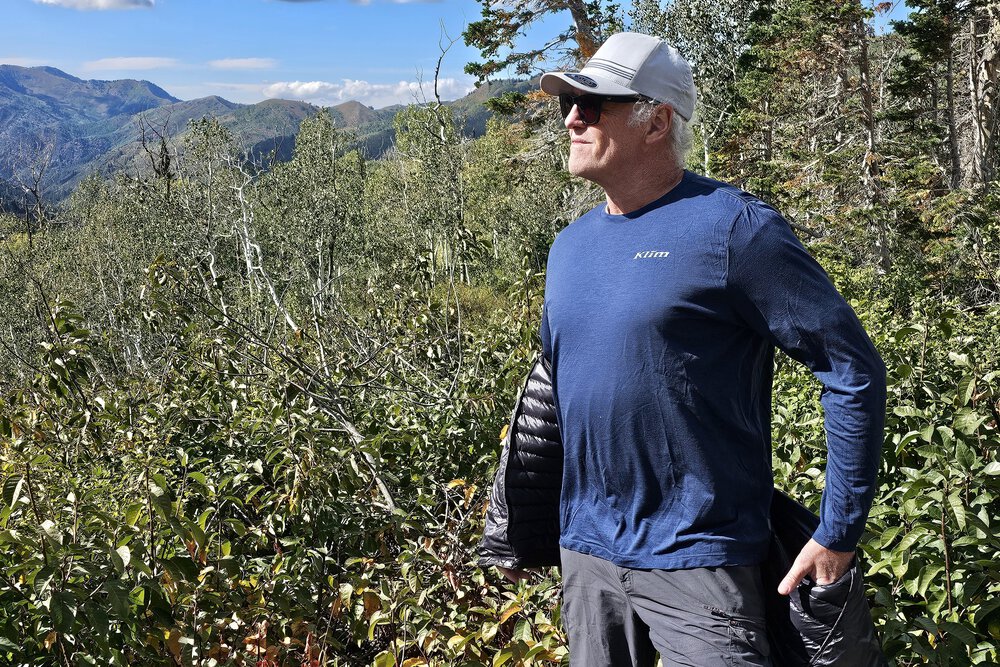
Fitting slightly loose, the shirt is just as soft and comfortable as the boxers and pants and performs identically in terms of breathability, insulation, reactive temperature regulation, moisture wicking, multi-day odor resistance, and durability.
It has become my favorite base layer and is now an integral part of my riding kit and casual wardrobe. I like its neutral color, low-key look, and understated elegance, a far cry from the garish motocross jerseys in bright colors that require sunglasses to look at. I often wear it on my bicycle rides to a lunch meeting in the city, reassured it won’t show sweat stains thanks to its moisture-wicking capability.
While writing this review, I was trying hard to come up with any drawbacks I could think of, as that’s what I’m expected to do as a gear reviewer. But since I’m very happy with the quality, fit, and performance of the Klim Teton merino wool base layers, there’s simply nothing negative to discuss.
At $80, the Klim Teton merino wool LS Shirt is priced competitively compared to other high-end brands. Like the boxers and pants in the Teton Merino wool line-up, the fit, quality, comfort, and thermal performance of the LS Shirt surpassed my expectations.
Given how often I wear my Klim merino wool base and mid-layers, I find the Klim Teton product line great value and I fully recommend it to be a part of your technical base layers. You can find cheaper synthetic shirts, boxers, and pants, but they won’t perform as well and will stink after a day. I won’t leave on a trip without my Klim Teton Merino Wool Long-Sleeve Shirt, Pants, and Boxers.
Primary Rating:
5.0 | Primary Rating:
5.0 | Primary Rating:
5.0 |
Klim Teton 1/4 Zip Reviewed
Klim pitches its redesigned Teton Merino Wool ¼ Zip Shirt as the ultimate everyday multi-tool mid-layer that’ll keep you warm on and off the bike on cooler days. It’s a versatile shirt that feels soft and comfortable. It’s made of a thick lofty elastic fabric of high-quality merino wool reinforced with nylon for durability.
Like the Klim Teton merino wool base layers, the Teton ¼ Zip Shirt benefits from the same qualities being breathable, multi-day odor-resistant, and reactively regulating body temperature.
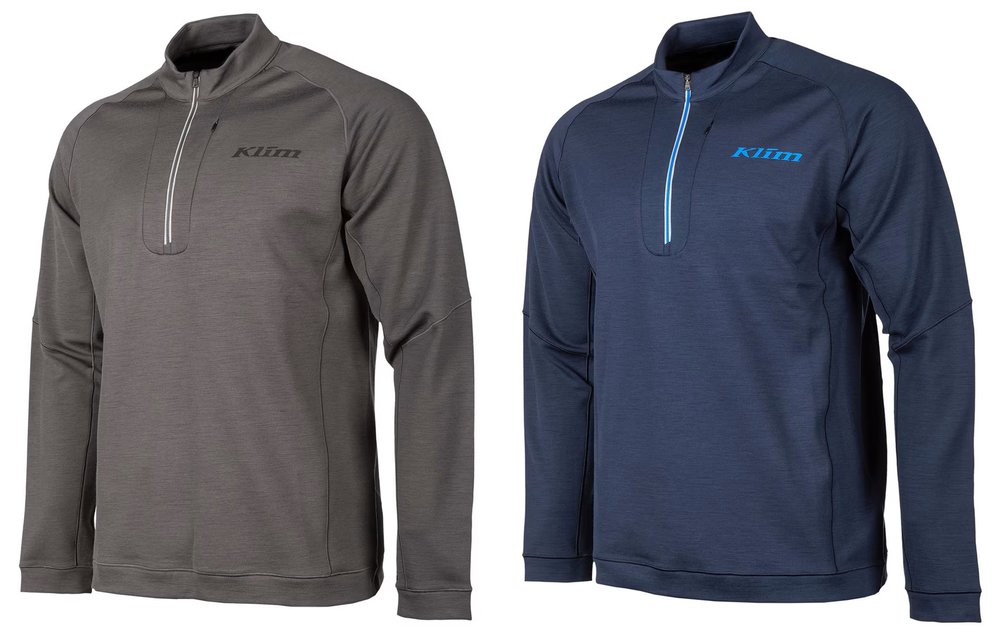
You can wear it as a middle layer when riding in cooler weather, or just on its own for casual occasions. Its understated design, subdued features, and high-quality finish make it suitable for various settings. This shirt is a practical and comfortable choice for everyday wear.
In addition to keeping you warm and comfortable in inclement weather, this modular layering system of Teton base layers and Maverick Down Jacket offers great versatility. The various ways to combine the base and mid-layers allow you to adjust the level of insulation or warmth required to cope with the cold.
I put this ¼ zip shirt to the test on multiple journeys on three continents to see if it lives up to its promise as a mid-layer under my motorcycle jacket and as a stand-alone casual jacket.
The ‘quality feeling’ of the Teton ¼ Zip Shirt’s fabric was the first thing that impressed me. Like its Teton base-layer siblings, it’s constructed from a soft merino wool/nylon blend, but the fabric is much thicker and loftier. This blend prioritizes the natural benefits of merino – breathability, odor resistance, and temperature regulation – while nylon adds durability to the material. Merrow stitching (AKA overlock) ensures chafe-free seams for comfort.
This garment is the ultimate temperature regulator: during hot days, the shirt excelled at wicking away moisture, keeping me cool and dry. When temperatures dipped, the wool’s natural insulating properties provided warmth without feeling bulky. The ¼ zip closure proved to be a valuable feature, allowing for quick venting when needed and providing extra protection against wind chill when fully zipped.
One of the most appealing aspects of merino wool is its natural resistance to odor. Even after extended days in the saddle, the Teton ¼ Zip remained surprisingly fresh, similar to the Teton merino base layers. Keeping the stink at bay is a significant advantage, allowing you to pack lighter without risking being labeled a biohazard.
As far as durability, blending nylon into the merino wool helps this shirt keep its shape through daily wears and washes, and adds wind resistance to the insulation capacity.
The Teton ¼ Zip classic design with raglan sleeves allows for unrestricted movement on the bike. The slightly longer back is a nice touch, preventing bunching while riding.
The zip of the external chest pocket (large enough for a phone or wallet) is cleverly hidden in the seam of the front panel housing the main ¼ zip, while a subtle Klim logo next to it adds a touch of style. The ¼ zip features light-reflective striping for visibility in the dark.
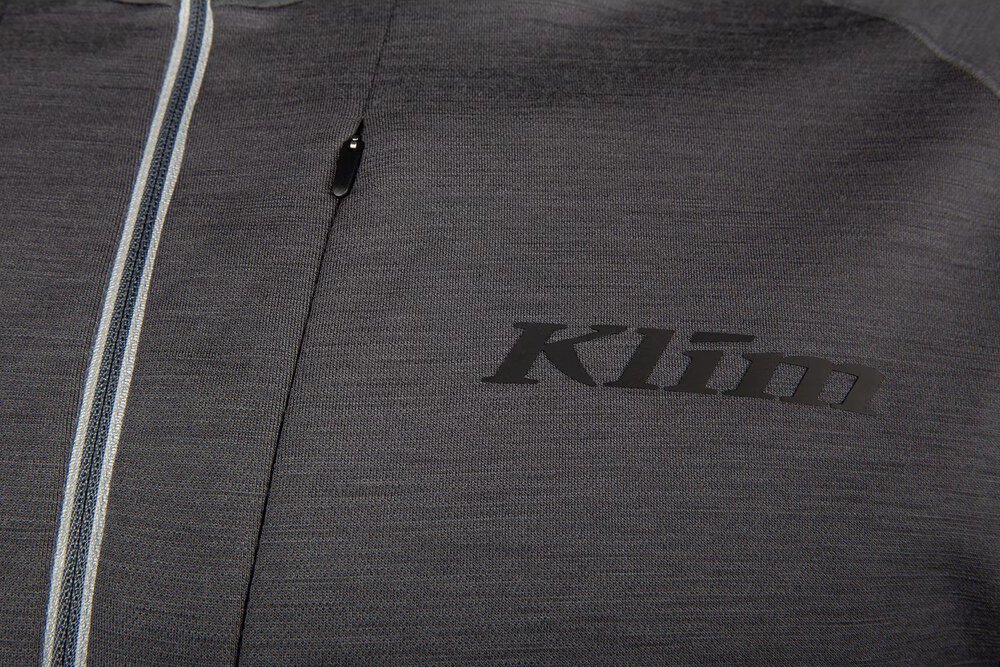
The Verdict
The Klim Teton Merino Wool ¼ Zip Shirt is a versatile and valuable addition to my technical layering system. Its performance across various temperatures, wind resistance, impressive odor resistance, and comfortable design make it a top choice for layering. The ¼ zip closure adds functionality for on-the-go temperature management. While the price point ($130) might be slightly higher than some synthetic base layers, the natural properties of merino wool and the overall quality of the garment justify the investment.
Beyond living up to my high expectations of warmth and comfort, it impressed me with its durability and versatility. Just like the Maverick puffer jacket, the ¼ zip shirt has become a staple in my casual wardrobe.
An excellent merino wool mid-layer on and off the bike.
Specs
- Custom blend of merino wool/nylon for greater durability
- Lofty knit from premium merino wool fibers for exceptional comfort
- Low profile merrow stitching for comfort
- One hidden external chest pocket
- Extremely versatile – regulates body microclimate in hot and cold conditions
- Antimicrobial and multi-day odor-resistant
- Maintains insulating value even when wet
- Slightly loose fit
- Raglan sleeves
- Zipper garage
- Breathable
- Naturally stain resistant
- Static resistant
Klim Maverick Down Jacket Reviewed
If you’ve ever found yourself questioning all your life choices while shivering on a motorcycle, teeth chattering so hard your twitching jaw muscles break the wind-blown frozen layer of snot on your face, then a warm puffer jacket might well be your next new best friend.
Patched up and looking ragged and forlorn from years of abuse on my two-wheeled adventures, my old down jacket was beyond retirement age. Getting lighter after shedding most of its feathers through the stitch holes of the sewn-through baffles, I figured it was time to upgrade my thermal mid-layer. Enter Klim’s best-selling Maverick Down Jacket.
This jacket went so far beyond my expectations in comfort and versatility that I’m wearing it as a daily around-town jacket, as well as on the motorcycle.
Let’s get down to the nitty-gritty of this technical mid-layer.
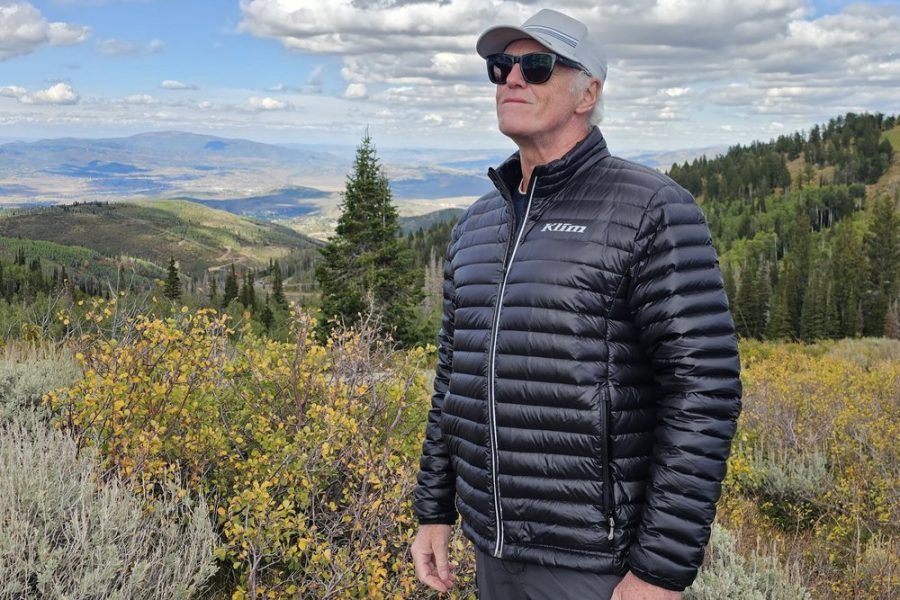
The first thing you’ll notice is that the Klim Maverick Down Jacket is ultralight. It feels almost weightless, to the point where you wonder how such an ethereal puffer jacket can keep you warm. But after wearing it in brutally cold conditions, I can vouch for its effective thermal insulation. I never had a piece of clothing so incredibly light and warm as the Klim Maverick.
A down jacket for more than motorcycle riding. This weightless and highly packable gem is a daily around-town jacket as well.
- Featherlight (pun intended)
- Packs down small
- Laughs at rain and wind
- No hood
The Secret to Light + Warm: Down Fill Power
How did Klim pull off the opposing design objectives of insulation and weightlessness?
The secret sauce lies in its filling: The Maverick is packed to the gills with 800-fill-power down. Klim’s puffer jacket is fluffier than white cotton ball clouds in a blue sky on a mid-summer day… but way more practical.
If you’re not familiar with the fill power rating scale for down-filled apparel, then check out my article on layering in general.
The mid-layer, as any outdoors gear nerd will tell you, is crucial for staying warm when the going gets rough, temperature-wise. Goosedown still reigns supreme in the world of cold weather performance gear for extreme outdoor activities. It holds onto more air than any other material, meaning it keeps you warm and toasty without weighing you down.
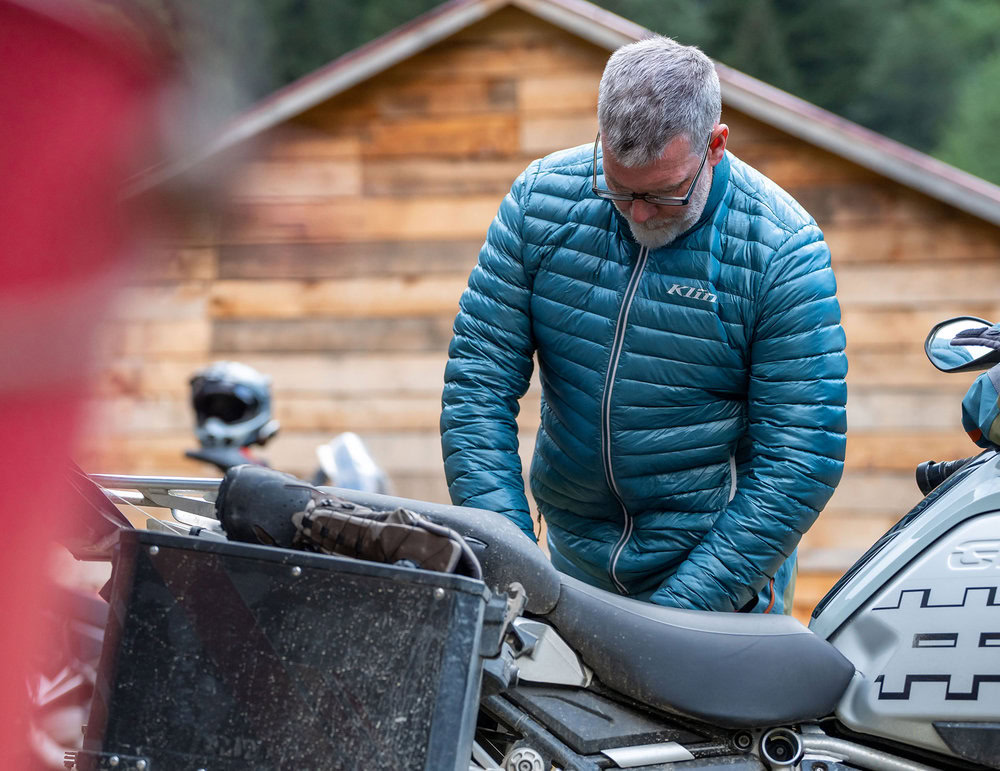
The 800 fill-power goose down is super-efficient at keeping you warm without needing much of it. The down is 90/10 Responsible Down Standard (RDS) certified gray goose down. So you can feel good in a PC kind of way, knowing that the geese were treated humanely before generously donating their fluffy feathers to a charity-endorsed good cause, namely your comfort.
The 90/10 goose-down ratio indicates that the jacket filling consists of 90% down and 10% feather. This ratio is also known as the down-to-feather ratio or down-cluster ratio. The higher the down percentage, the better the warmth-to-weight ratio and the higher the quality and thermal insulation of the puffer jacket.
Down is better at providing warmth and comfort than feathers, which can push through fabrics and are more suited to harder, more durable products. Another advantage of top-quality down with high fill power is that it lasts and keeps its loft a lot longer than cheaper, lower fill-power down.
With the Klim Maverick Down Jacket, you’re getting top-tier insulation without looking like the Michelin Man—a win for both warmth and style.
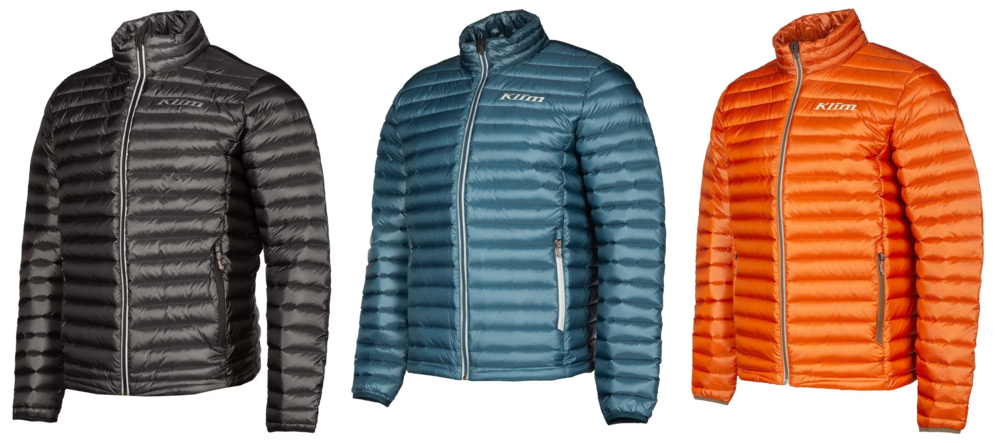
Klim has another trick with this jacket: they engineered seamless down baffles, which not only sounds fancy but also means you won’t have down feathers poking out of stitch holes.
The baffle box construction method is a far superior design compared to the cheaper sewn-through construction which is notorious for shedding feathers and having cold spots at the seams. You can find out more about the ins and outs of puffer jacket construction in the relevant section in my article about layering in general.
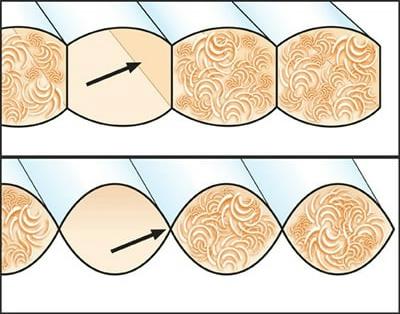
Another advantage of the baffle box construction is that there are no visible sewing threads on the seams that risk getting caught on Velcro every time you put it on.
The windproof, water-repellent outer shell is made of 20D nylon fabric. I found that the Maverick is impervious to wind, performing better than expected. I’ve often ridden in the city in freezing temperatures just wearing my puffer jacket and never felt the need to don a windproof outer shell.
I’ve also worn my Maverick jacket while walking and cycling in light rain. The nylon fabric is treated with a DWR coating (Durable Water Repellent), and the raindrops just run off the jacket. So you won’t have to worry about getting soaked in a drizzle. Now, if it starts pouring cats and dogs, you might want to reach for a rain jacket, but this bad boy will hold its own in most conditions.
One of the practical features of the Maverick is that it packs very small, hardly taking up any space when storing it in your backpack or tank bag. The jacket folds up into one of the zippered hand pockets. So there’s no separate storage pouch that risks getting lost or that you don’t have with you when you need it. It’s the jacket version of a burrito—compact, satisfying, and always a good idea.
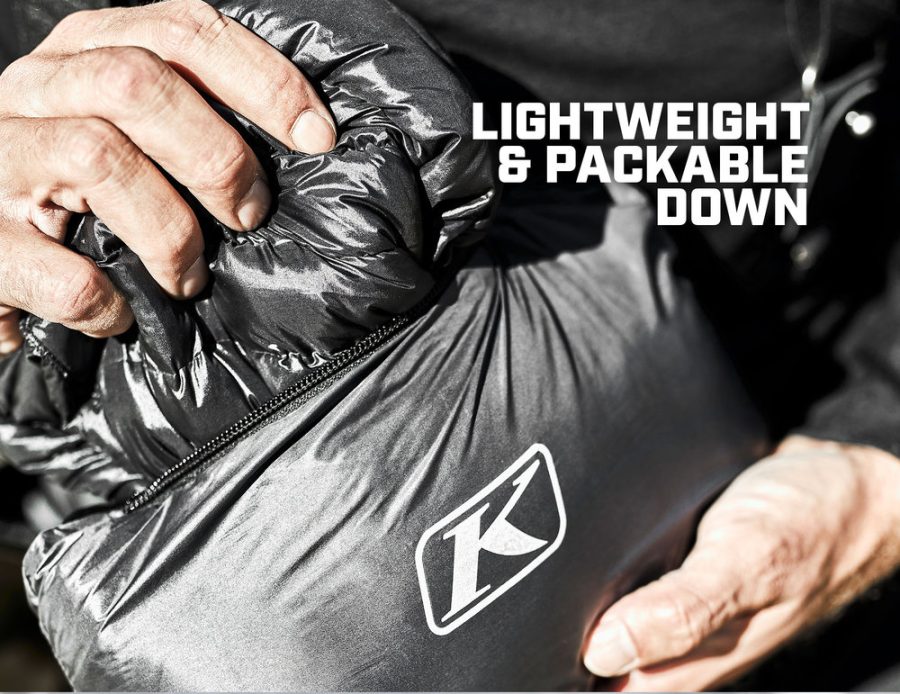
The Maverick is low-profile, easily fitting under your riding jacket, and the in-pocket bottom hem drawcord adjustment lets you get the perfect fit. One quick tug keeps the warmth in while the jacket is loose enough you don’t feel like a sausage.
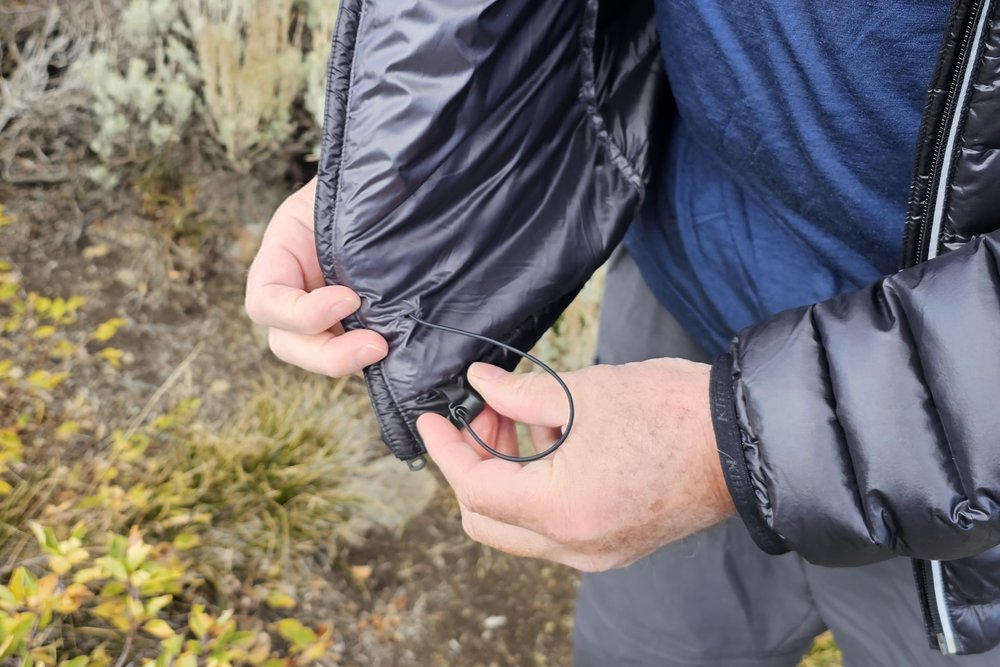
The soft fabric zipper garage at the top of the main zipper is an easily overlooked small detail, but one that prevents the metal zipper slider from irritating the skin of your throat. My previous puffer jacket didn’t have a zipper garage, forcing me to leave the zipper open at the top to avoid the slider scratching my skin. This was especially annoying when cinching the outer jacket’s collar tight to prevent cold air ingress.
Another minor detail that makes the Maverick more user-friendly is the spring-loaded pull tab keeping the locking pin firmly in position, preventing the zipper from sliding open inadvertently. Little things make a difference, right?
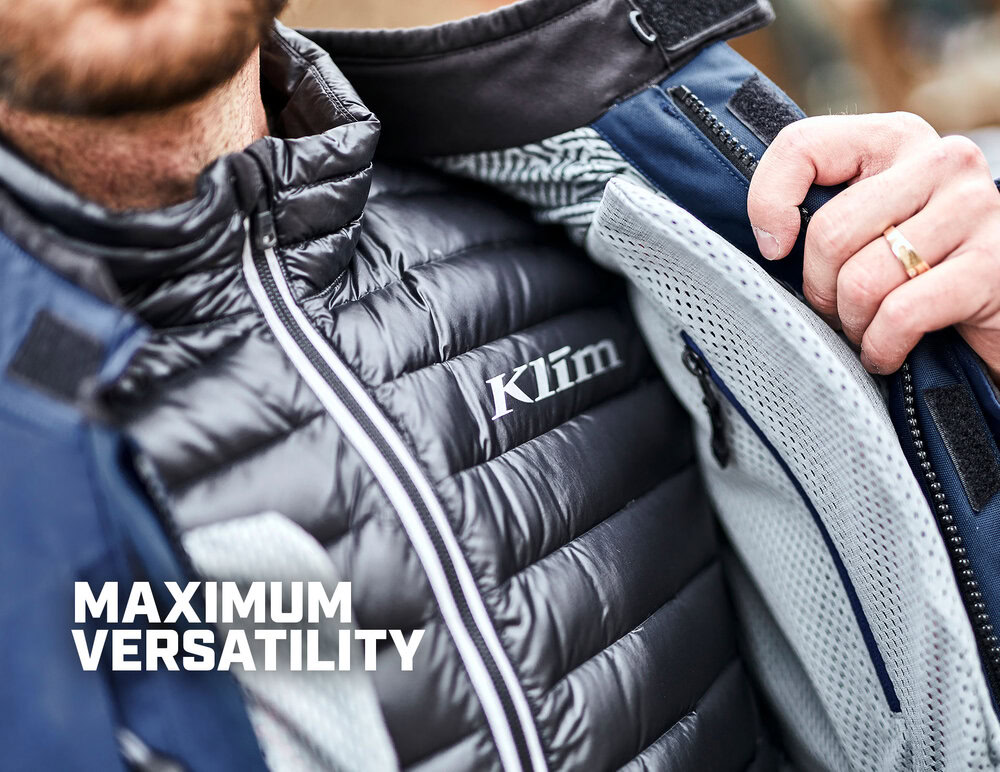
The jacket also has two zip hand pockets, perfect for securely storing all the essentials—keys, phone, wallet, or… the jacket itself. Turned inside out, the right-hand side pocket doubles as the storage pouch for the jacket.
Klim didn’t forget about safety, even though this is technically a mid-layer. But they know many owners also use it as a casual puffer jacket for everyday use. The jacket comes with 3M™ Scotchlite™ reflective material, which means you’ll shine bright like a diamond—or at least be visible to oncoming traffic.
The Klim Maverick Down Jacket is now a cornerstone piece of my casual spring/winter/fall wardrobe. It’s my go-to jacket on cold days and it gets worn a lot more than any of my other casual jackets. Whenever I can’t find it when I’m about to leave the house, it’s because my son is wearing it. I wear it while walking the dog, on my bicycle, and on my trips into the city.
Drawbacks
The main drawback is that the Maverick doesn’t sport a hood. It would be nice to have a puffy hood (that folds away in the collar) to keep your noggin and ears warm when it’s cold and windy. Besides using the Maverick for layering under my riding jacket, I also use it as a daily casual jacket.
Another drawback is the lack of a lanyard sewn in the hand pocket that doubles as its storage pouch. When I take it off and stow it away in the turned-inside-out hand pocket, I have to hold it when I don’t bring a bag. It would be convenient to have a lanyard to hang it on my wrist or with a carabiner from my belt. Minor, but annoying.
Are you reading this, Klim designers in Rigby, ID?
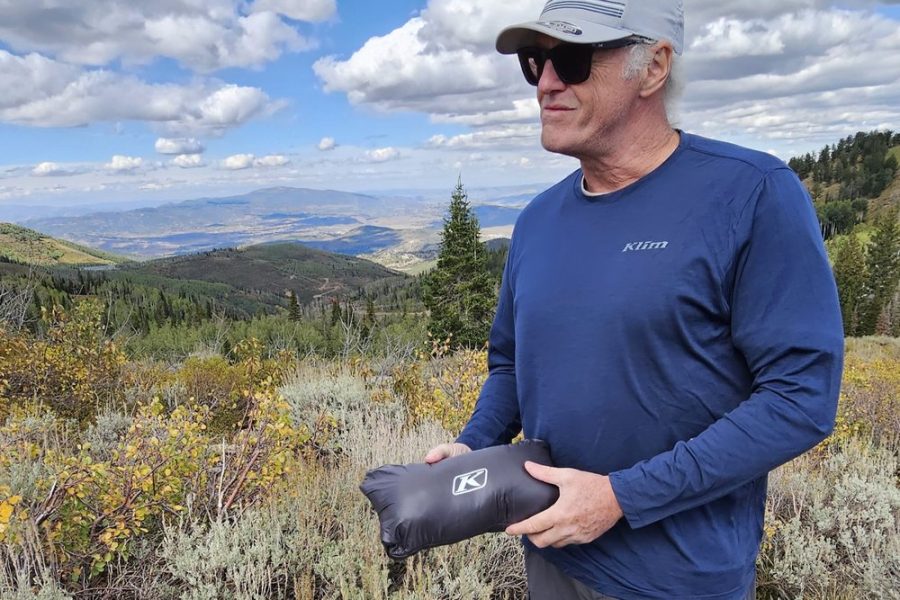
Also, keep in mind that premium fill-power goose down commands a premium price. It’s used to keep puffer jackets ultralight, ultra-packable/compressible, and ultra-insulated. But the great part about high fill-power is it lasts long – so you won’t have to buy a new jacket in a year or two (like I did).
When you compare prices, make sure you compare apples to apples. The construction method (baffle box vs sewn-through), the quality (fill power and down-to-feather ratio), and the quantity (fill weight) of the down filling largely determine the cost. Also, goose down is more expensive than duck down and synthetic insulation like, for example, PrimaLoft or Thinsulate. As far as technical base layers from other brands, the Maverick is about the same price but also made for motorcycling.
Final Thoughts
The Klim Maverick Down Jacket is the kind of gear you’ll wonder how you ever lived without. It’s warm, comfy, super-light, and packed with smart features making it perfect for riding in cold weather. Plus, it’s so packable that it takes up almost no space in your tank bag or panniers, leaving plenty of room for the other essentials.
In short, the KLIM Maverick Down Jacket was a total win on all my ADV journeys on three continents. It teamed up perfectly with my Klim Badlands Pro A3 Jacket and Klim Traverse Jacket, and I was never once left out in the cold—literally or figuratively.
So, if you’re tired of shivering your way through cold rides and defrosting your shriveled nuts with your hand warmers, do yourself a favor and snag one of these Klim Maverick Down Jackets.
A down jacket for more than motorcycle riding. This weightless and highly packable gem is a daily around-town jacket as well.
- Featherlight (pun intended)
- Packs down small
- Laughs at rain and wind
- No hood
Specs
- 800-fill-power down.
- 90/10 Responsible Down Standard (RDS) certified gray goose down.
- Engineered seamless down baffles (reduces down loss, no stitching to snag on Velcro).
- Highly wind-resistant 20D nylon fabric.
- Packs into its own pocket.
- Durable Water Repellent (DWR) treatment on the fabric.
- Low profile cuff binding.
- 3M™ Scotchlite™ reflective material.
- 2 zip hand pockets.
- Low-profile elastic cuff binding traps heat.
- Low profile in-pocket bottom hem adjustment.
- Zipper garage.
Check out my article on layering in general where I break down materials and construction. Even after trying almost all the other base layers on the market: All the Klim base and mid layers in this article are the best (and best value) layers out there right now.
Primary Rating:
5.0 | Primary Rating:
5.0 | Primary Rating:
5.0 |
Related

Pando Moto Onyx 02 Gloves Review: The Break-In That Changed Me
Too tight at first, perfectly molded after break-in. Quality leather gloves worth the patience for classic motorcycle riders.

